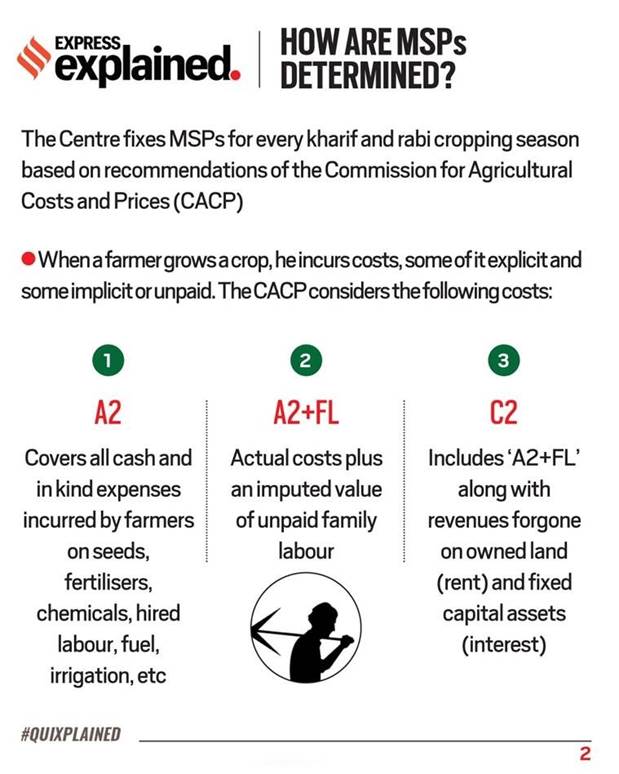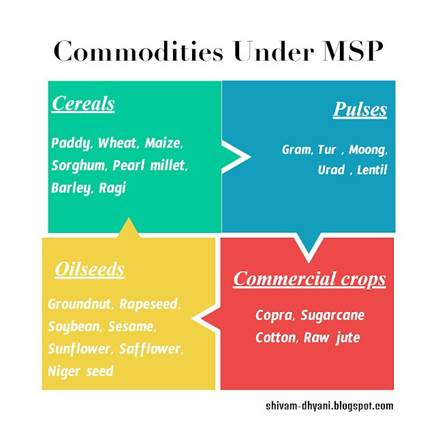Description

Disclaimer: Copyright infringement not intended.
Context
- The Union cabinet raised the minimum support price for wheat by 5.45 per cent to Rs 2,125 per quintal from Rs 2,015 per quintal to encourage bringing more area under the crop amid tight government stocks.
- Besides wheat, the government has hiked the minimum support price (MSP) of five rabi crops by up to 9 per cent.
What is MSP?
- The minimum support price (MSP) is an agricultural product price, set by the Government of India to purchase directly from the farmer. This is not enforceable by law.
- This rate is to safeguard the farmer to a minimum profit for the harvest, if the open market has lesser price than the cost incurred.
Details
- Government of India announces Minimum Support Prices (MSP) for 23 major agricultural commoditiesof Fair Average Quality (FAQ) each year at the start of the planting season in both the Crop seasons.
- It does so after taking into account the recommendations of the Commission for Agricultural Costs and Prices (CACP).
- The MSP framework was begun in 1966-67 for wheat and extended further to incorporate other fundamental food crops and afterward offered to the poor under the public distribution framework under subsidized rate.
Calculating MSP
- Since 2009, the Commission for Agricultural Costs and Prices fixes the MSP of a crop based on:
- cost of production
- demand
- supply
- price fluctuations
- market price trends
- different costs and
- international market prices
- agricultural wage rate


Procurement
- The procurement at MSP is being done by Central and State Agencies under various schemes of Government.
- Procurement centres are opened by respective State Government Agencies and Central Nodal Agencies like NAFED, FCI etc.
- This is done after taking into account the production, marketable surplus, convenience of farmers and availability of other logistics / infrastructure such as storage and transportation etc.
Is the MSP Different in different states?
- Because of the variety in irrigation and wages, the expense of a similar yield changes from one state to another. However, there is no draft of the local Minimum Support Price, so there is one MSP for the whole country.
Current Status of MSP: Pros, Cons & what can be done better?
- The MSP comes as a much relief to many farmers.
- The trouble with MSP is that while it is touted as an all-important factor for farmers promising an instant rise in their income and stability, it also has many drawbacks in implementation.

Significance of Minimum Support Price
- Fixed Remunerations– The farmers are financially insured against the impulses of price fall in the market. It gives security to farmers from crop loss and price uncertainty.
- Help in Decision Making– MSP are reported toward the start of the planting season, this assists farmers with settling on the best choices of crop that they should plant. This development data assists the farmer with settling the best choice with regards to which yield to plant for the most extreme monetary advantage inside the restrictions of his agricultural land size, environment, and irrigation framework.
- Crop Diversification– The MSP declared by the Government of India without precedent for 1966-67 for wheat has been reached out to around 24 crops at the present. This has urged the farmers to develop these different crops to maximize their agricultural income.
- Price Limitations for Private Purchasers– MSP conveys a value message to advertise that if vendors don’t offer higher than MSP costs the farmer may not sell them his produce. In this manner, it goes about as an anchor or benchmark for agricultural produce. It guarantees the market costs won’t be radically lower than Minimum Support Price.
- Commercial Crops– MSP is utilized as an instrument to boost the creation of explicit food crops which is short in supply. MSP spurs farmers to develop commercial crops and expanded creation on a commercial basis.
- Purchasing Power Enhancement– MSP provides fixed amounts in framers’ hands which make them financially stable. It helps in upgrading the buying limit and updating the style of living of farmers and their families.
- Empowers farmers: It is a one-price policy guaranteeing assured pay, which directly influences farmer’s pockets. It considers various factors when fixing the price and does not leave the farmer at the mercy of the market.
Cons of MSP
- Low Number of Beneficiaries – The advantages of this plan don’t arrive at all farmers and for all crops on the farm. Not all farmers have had the option to get the advantages of MSP due to the absence of awareness about MSP schemes. There are numerous locales of the nation like the north-eastern district where the execution of MSP schemes is week.
- Inadequate Storage Facility– MSP without adequate storage capacity has brought about immense heaping of stocks in the stockrooms. The stock has now become twofold the necessities under the plans of PDS, Buffer stock and so there is the requirement of more storage space for these agricultural produces.
- Market Bending – It misshapes the unrestricted economy by preferring some specific crops over different yields.
- Fiscal Pressure– Open-finished acquisition of paddy and wheat at MSPs is totally out of sync with market costs and leads to financial unbalance in the economy.
- Impact on Export– Hikes in MSP likewise antagonistically influence the export by making Indian products un-cutthroat particularly when worldwide market costs are lower.
- Natural Issue– MSP prompts non-logical farming practices whereby the soil, water is worried to a degree of depletion groundwater table and salinization of soil.
- Yield Variety– MSP influences the crop variety in India. With MSP editing designs get influenced as it prompts the creation of MSP upheld only those crops as it ensures returns.
- Short term relief: Hiking the MSP without investing in infrastructure is just a short-term play. While it does deliver immediate results, long-term developments to back-it up are also important.
- Contradicts Committee recommendations: MSP covers numerous costs such as the cost of sowing (A2) and labour (FL). These considerations are controversial with suggestions of Swaminathan Committee that it should be based on comprehensive costs (C2), which also include land rent costs.
- Inflation: Too much of a hike on MSP either paves way for inflationary effects on the economy, with a rise in prices of foodgrains and vegetables, or loss to government treasury if it decides to sell at a lower price as compared to the higher MSP it bought at.
- Disparity: MSP is a nationwide single price policy. However, the actual costing for production varies from place to place, more severely so in areas lacking irrigation facilities and infrastructure. Thus, not all farmers have equal benefits.
- Market value way and above MSP: Market prices should ideally never be below MSP. If they fall below the MSP, in concept, the farmer can always sell it to the government, which will then resell it or store as buffer. However, practically this does not always happen. The market value in many cases does fall below MSP due to lack of infrastructure and procurement apparatus on the government’s end.
- Ensured for fewer crops: MSP is notified for 23 crops, but effectively ensured only for two-three crops. Thus, MSP while still being significant is not the only go-to solution for solving all farmer woes.
Way Ahead
Alternative Options for MSP-
- Substitute Pay Models– Instead of depending on MSP alone, the public authority needs to investigate substitute models to support farmers.
- Value Deficiency Payment– To take care of the issue of MSP, Both NITI and Economic Survey suggest Price Deficiency Payment (PDP) in which the public authority pays the farmers the contrast between modular rate (the normal costs in major mandis) and theMinimum
- Support Price. A few states like Madhya Pradesh (Bhavantar Bhugtan Yojana), Haryana government (Bhavantar Bharapai Yojana) have dispatched value shortage financing plans.
- DBT Support– By moving from cost to pay support, all market-twisting info and yield appropriations can be imploded into the Pradhan Mantri Kisan Samman Nidhi or PM-KISAN scheme.
- Stock Should be Diversified– The public authority should stock adequate amounts of all fundamental food things not just rice and wheat, that empower powerful market mediation, with the premium of helpless buyers better dealt with through designated cash moves.
- Deficiency Price Payment: The Govt. can also go for the alternative of ‘deficiency price payment’without requiring the government to purchase undesirable quantities and undesirable commodities. Deficiency price payment must be part of the difference between the actual price received by farmers and the MSP. Example: The Madhya Pradesh government has launched a ‘Price Deficiency Payment’ schemes for the farmers.
- Swaminathan Commission: It prescribed MSP 50 per cent above C2.
- Direct Income Transfers for Non-Staple Food Crops: Public procurement needs to continue for staple cereals, but farmers of non-staple food crops need to be provided with direct income transfers. These are fiscally prudent, obviate the need for physical procurement and storage by the government, do not distort current production, and also provide a basic income to farmers.
https://www.telegraphindia.com/business/centre-raises-minimum-support-price-for-wheat-and-mustard-to-boost-output/cid/1892892
















